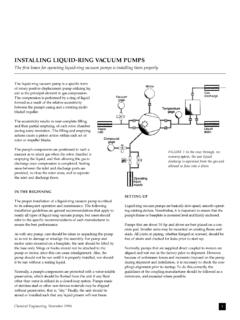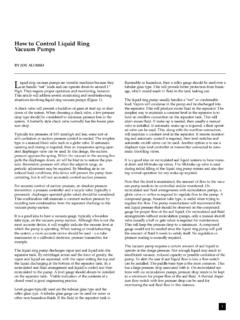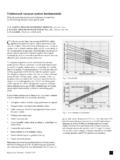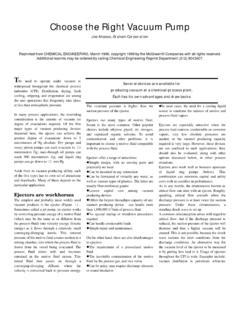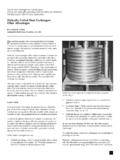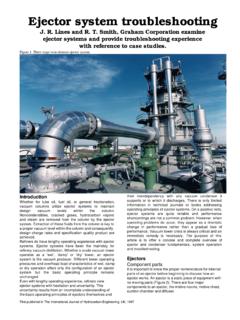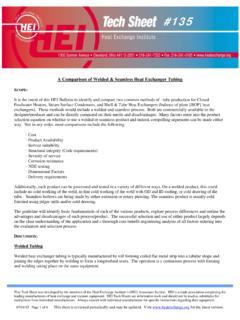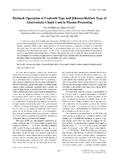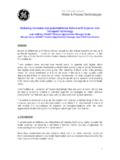Transcription of Understanding ejector systems necessary to …
1 TECHNOLOGYU nderstanding ejectorsystems necessaryto troubleshoot vacuum distillationJames R. Lines Graham Corp. Batavia, complete Understanding of ejectorsystem performance characteristics canreduce the time and expense associatedwith troubleshooting poor crudevacuum distillation unit (CVDU) that may negatively impactthe ejector - system performance ofvacuum-crude distillation units includeutilities supply, corrosion and erosion,fouling, and process 2 Tables 1 and 2 are troubleshooting guides toejector and condenser problems in vacuumejector systems . Fig. 1 is a photo of aninstalled ejector at a actual case studies conducted by serviceengineers on CVDU- ejector systems showhow to troubleshoot ejector problems. Thefirst problem was a result of improperreplacement of an intercondenser, and thesecond was a result of underestimation ofnoncondensible loading during design, whichhas recently become a common ejector converts pressure energy ofmotive steam into velocity.
2 It has no movingparts. Major components of an ejectorconsist of themotive nozzle, motive chest, suctionchamber, and diffuser (Fig. 2).High velocity is achieved through adiabaticexpansion of motive steam across aconvergent/divergent steam nozzle. Thisexpansion of steam from the motive pressureto the suction fluid operating pressure resultsin supersonic velocities at the exit of thesteam motive steam actually expands to apressure below the suction fluid expansion creates a low-pressure region,which draws suction fluid into an , velocity exiting a motive steamnozzle is in the range of 3,000-4,000 fps. Thishigh-velocity motive steam then entrains andmixes with the suction fluid. The resultantmixture is still supersonic. As the mixturepasses through the convergent, throat, anddivergent sections of a diffuser, high velocityis converted back to convergent section of a diffuser reducesvelocity as cross sectional area is , one normally thinks that as flowarea is reduced, velocity is increased.
3 But aunique thermodynamic phenomenon occurswith gases at supersonic conditions: Ascross-sectional flow area is reduced, thevelocity is diffuser throat is designed to create ashock wave. The shock wave produces adramatic increase in pressure as the flow goesfrom supersonic to subsonic across it. In thedivergent section of the diffuser, cross-sectional flow area is increased and velocity isfurther reduced and converted to pressure. Ashock wave occurs in the diffuser throat whenthe compression ratio of an ejector is 2:l orgreater, which is the case with CVDU ejector -performance curve gives theexpected suction pressure as a function ofwater-vapor equivalent loading (Fig. 3). HeatExchange Institute Standards for Steam JetEjectors describes the method to convert themixture (air, water vapor, and varioushydrocarbons) to a water-vapor equivalent oran air-equivalent important information noted on anejector performance curve includes theminimum motive steam pressure, themaximum motive steam temperature, andFig.
4 5the maximum discharge field measurements differ from aperformance curve, then there may be aproblem with the process, utility supply,or the ejector condenser in an ejector system reducesthe amount of vapor load that adownstream ejector must of an ejector system aredesigned to condense steam andcondensible hydrocarbons and coolnoncondensible many cases, the inlet load to acondenser is many times greater thanthe load to a downstream , any loss in condenserperformance will have a dramatic ef-fecton a downstream vacuum condensers areconstructed like process shell-and-tubeheat exchangers, their internal designsdiffer significantly due to the presenceof two-phase flow, noncon-densible gas,and vacuum condensers for crude-towerapplications have cooling water on thetube side.
5 Condensation of water vaporand hydrocarbons takes place on theshellside. A major portion of thecondensibles contained in the inletstream (shell side) change from a vaporto liquid phase. The remainingcondensibles and the noncondensiblegases are removed from the condenserthrough a vapor-outlet connection by adownstream are positioned be-tween two ejector stages. Condensationof intercondensers occurs at a pressurecorresponding to the dis-charge pressureof a preceding ejector and the suctionpressure of a downstream pressure and temperatureThe temperature and pressure ofmotive-steam supply is one of the mostimportant variables affecting ejectoroperation. If the pressure falls belowdesign pressure, then the motive nozzlewill pass less steam.
6 If this occurs, anejector does not have enough energy toentrain and compress a suction load tothe design discharge , if the motive-steam supplytemperature is appreciably above thedesign value, insufficient steam passesthrough the motive nozzle. Both lower-than-design steam pressure and higher-than-design steam temperature increasethe specific volume of the motive steamand reduces the amount of steamthrough a motive certain cases, it is possible to re-borean ejector -motive nozzle to permit thepassage of more steam through thenozzle, thereby increasing the energyavailable to entrain and compress thesuction motive-steam pressure is more than20% above design, too much steamexpands across the nozzle. This oftenchokes the diffuser throat of an this occurs, less suction load ishandled by an ejector , and the CVD-column pressure rises.
7 If an increase incolumn pressure is undesirable, thennew ejector nozzles with smaller throatdiameters are qualityWet steam is very damaging to anejector system because high-velocitymoisture droplets are erosive. Thesedroplets are rapidly accelerated as steamexpands across a motive of nozzle internals caused bywet motive-steam is noticeable wheninspecting ejector nozzles or diffuserinternals. There is an etched striatedpattern on the diverging section of amotive nozzle, and the nozzle mouthmay actually wear out. Also, the inletdiffuser section of an ejector will showsigns of erosion as a result of directimpingement of moisture droplets ( ).Fig. 4b depicts an ejector cutawayshowing severe damage caused by wetsteam.
8 The inlet diffuser showsTable 1 Table 3substantial metal loss. Metal-scale buildupcan be seen in the outlet diffuser exhaust temperature from the ejector candetermine if the steam conditions are ejector exhaust temperatures are inthe range of 250 to 300 F. If moisture ispresent, a substantially lower exhausttemperature will solve wet-steam problems, all lines up toan ejector should be well insulated. A steamseparator and trap should be installedimmediately before the motive-steam inletconnection of each ejector . In some instances,a steam superheater may be steam can also cause performanceproblems. Moisture droplets through anejector nozzle decrease the energy availablefor compression. This reduces the suction-load handling capacity of an , the moisture droplets may vaporizewithin the diffuser section of the vaporization, the volumetric flow ratewithin the ejector increases.
9 Here again, thisreduces the suction-load capacity of water conditionsA rise in cooling-water temperature lowersthe available log mean temperature difference(LMTD) of a condenser. Should this occur,the condenser will not condense enough steamand condensible hydrocarbons. This willincrease the vapor load to the a result of inadequate condensation, therealso is an increase in pressure drop across thecondenser. If an ejector following thiscondenser cannot handle an increased vaporload at the operating pressure of a condenser,the operating pressure of the condenser willrise and the system will break ejector system performance ischaracterized by a higher-than-design CVDU tower-top pressure. The tower-top pressuremay become may also occur if the cooling-water flowrate is below design.
10 At lower-than-designflow rates, there is a greater water-temperature rise across a condenser. Hereagain, this will lower the available performance is further exacerbated as aresult of a lower heat transfer coefficientresulting from low-water flow with cooling water normally occurduring summer months. During the summer,the water is at its warmest, and demands onrefinery equipment are highest. If cooling-water flow rate or temperature are off design,new ejectors or condensers may be requiredto provide satisfactory and erosionCorrosion may occur in ejectors, condensers,or vacuum piping. Extreme corrosion maycause holes and allow a system . Air leakageinto the vacuum system . Air leakage into avacuum system will deteriorate performanceand can result in broken ejector common corrosion problem occurs whencarbon-steel tubing is used in carbon steel may be suitable for thecrude feed-stock, it is not always the bestchoice for an ejector system .


